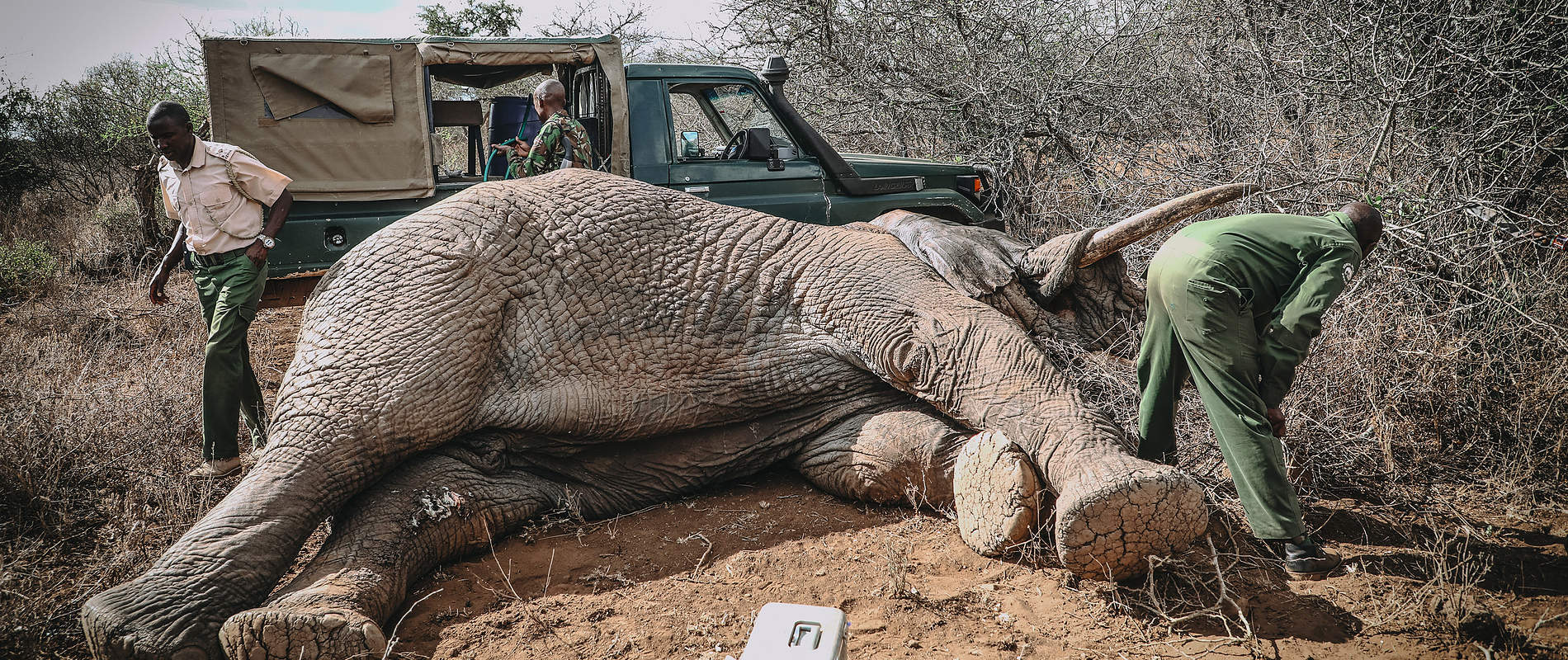A bull elephant in his prime is a magnificent sight to behold — and in the Amboseli-Tsavo ecosystem, these sightings are commonplace. On the morning of 6th November 2020, however, Big Life scouts near Kimana in Amboseli spotted something amiss: One of these kings of the plains had a gouge in the center of his forehead, with evidence of another septic wound to his rear leg. They reported this to the SWT operations room so that the SWT/KWS Tsavo Mobile Veterinary Unit could provide emergency treatment.

The patient was watched over by Big Life scouts while they waited for the SWT/KWS team to arrive

Dr. Poghon prepares to dart the elephant from the helicopter
These spur-of-the-moment treatments always entail many moving pieces. Over at Kaluku, we mobilised our ground teams while the airwing got ready to take flight. Dr. Poghon, who leads the SWT/KWS Tsavo Mobile Veterinary Unit based in Voi, drew up the anaesthetic dart and prepared for the rendezvous with our helicopter. We picked him up in Kamboyo, the Park Headquarters of Tsavo West, and then took the most direct route to the scene, flying west over the Chyulu Hills and beyond Kimana Sanctuary. All the while, two Big Life vehicles remained by the patient, ensuring he didn’t go far or fall into further peril.

The bull was darted from the air while a giraffe watched on

Once darted, the bull was guided by the helicopter to an open area to make treatment easier
After Dr. Poghon successfully landed the dart from the air, the helicopter gently guided the bull to a clearing. As soon as he succumbed to the anaesthetic, the teams moved in to commence treatment. Even for a patient of this size, small details are important. The midday sun was at its most potent and, as often happens, the bull fell asleep with his eyes open. One quick-thinking ranger donated his hat as a sort of elephant-sized sun monocle, protecting the exposed eye from damage.

One of the spear wounds was on his left back leg

The most pressing issue was the top wound, where a spear had been plunged directly in the middle of the bull’s impressive head. Fortunately, elephants have a large honeycomb structure that protects their brain. While the spear had sunk several inches into the skull, it had not broached into the cerebrum. Dr. Poghon focused his attention on another spear wound, to the back left leg. Given the level of sepsis, we estimate the injuries were inflicted up to seven days ago.

The second injury was deep into this forehead. A hat was used to cover his open eye from the sun

Despite being a deep wound, the spear had thankfully not penetrated beyond the honeycomb of his skull
With both wounds thoroughly cleaned out and necessary medications administered, Dr. Poghon reversed the anaesthetic. Everyone watched the patient rise to his feet before lumbering off, confident in his chances of recovery. He is in a protected area where he will be monitored by Big Life scouts as he convalesces, and we will be poised to administer follow-up treatment if required.

The revival drug being administered

This bull’s plight is synonymous with human-wildlife conflict. When an animal as large as an elephant marauds onto agricultural lands, they can devastate crops and cause enormous damage. Of course, this is a symptom of shrinking habitats: Human activities are increasingly taking over spaces that elephants have called home for millenia. If these kings of the plains are to have a future, we must help them — not just by rushing to their aid when they are injured, but also by setting aside space for wildlife and patrolling key habitats. We remain focused on this bigger picture, partnering the Masai community in Amboseli through our funding of land leases for the Kimana Corridor and Kimana Sanctuary. We will also continue to be there for any creature caught in the crosshairs of human-wildlife conflict, like this magnificent fellow.


After a job well done the team leave the patient under the watchful eyes of Big Life
